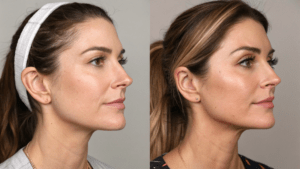
Jawline contouring is the ultimate hack for a sharp, defined face—until it isn’t. One wrong move, and instead of looking snatched, you end up looking… well, surprised, swollen, or just plain weird. Whether it’s too much filler, lopsided results, or a completely unnatural look, the risks are real. But don’t panic! If you’re planning on jawline contouring (or fixing a botched job), you’re on the right track. We’re here to talk about most common mistakes, how to avoid making them, and what to do if things go wrong.
1. Overfilling: When “Snatched” Becomes “Puffy”

If you’ve ever seen someone whose jawline suddenly looks too big for their face, that’s the classic case of too much filler. Instead of sleek and defined, you get bulky and unnatural.
How to Avoid It:
- Less is more. Always start with a conservative amount. You can add more later, but you can’t just “undo” excess filler overnight.
- Choose an expert injector. Not all practitioners have experience doing jawline sculpting—ensue that yours is skilled in facial aesthetics.
- Check symmetry. Some swelling is normal, but an experienced injector will ensure your jawline looks even on both sides.
How to Fix It:
If your jawline looks too full, hyaluronidase can dissolve hyaluronic acid fillers. But be patient—mild swelling after a procedure is normal and might settle in a week or two.
2. The “Frozen” Look: When Botox Goes Overboard

Botox can help sculpt the jawline by slimming the masseter muscles. But too much, and suddenly chewing feels like a workout, or worse—you lose natural movement altogether.
How to Avoid It:
- Go to someone who knows facial anatomy. Over-relaxing the masseter muscles can make your jawline look droopy instead of defined.
- Start small. You don’t need to paralyze your face to see results. A conservative dose works wonders.
- Don’t chase trends blindly. That ultra-slim jawline on Instagram might not be realistic (or necessary) for your face shape.
How to Fix It:
Unfortunately, Botox can’t be reversed instantly, but the good news? It wears off in 3 to 6 months, so you won’t be stuck with a stiff jaw forever.
3. Bad Injector = Bad Results (Let’s Not Sugarcoat It)
This is where people really get into trouble. Cheap treatments, inexperienced injectors, or someone who just watched a YouTube tutorial… all recipes for disaster.

How to Avoid It:
Ask questions. A professional should explain the procedure, risks, and expected results, not just rush you in and out.
Do your research! Not all injectors are created equal—check credentials, reviews, and before-and-after photos.
Beware of “too good to be true” prices. If someone’s offering jawline contouring for a fraction of the usual price, ask yourself why.
How to Fix It:
If your results look botched, don’t panic—consult a skilled injector to assess the damage and discuss corrective options. In some cases, filler reversal or additional treatments may help.
4. Not Considering Face Shape (One Size Doesn’t Fit All!)

A defined jawline is great, but what suits one face might not suit another. Some faces can appear too sharp or too much if there is too much of it.
How to Avoid It:
- Enhance, don’t erase. The goal is to improve your natural features, not force an unrealistic standard onto your face.
- Trust the pros. A skilled injector will recommend techniques that complement your face shape, not just follow generic trends.
- Look at real results, not just social media edits. Some jawlines on Instagram are more Photoshop than filler—keep expectations realistic.
How to Fix It:
If your contouring looks unnatural, options include dissolving excess filler or rebalancing facial proportions with additional tweaks. Consulting with an expert is key.
5. Ignoring Aftercare: Because Swelling Is Real

Even the most successful jawline contouring can look poor if good aftercare is not followed afterwards. Poor aftercare can exacerbate uneven outcomes, swelling, and bruising.
How to Avoid It:
- Skip alcohol and salty foods for at least 24 hours—they can make swelling worse.
- No touching or massaging the area unless instructed. You don’t want to move the filler around.
- Avoid intense workouts for a couple of days—blood flow can increase swelling.
How to Fix It:
Most swelling goes away within a week. Ice packs and staying hydrated help, but if things still look off after two weeks, go back to your provider for an evaluation.
Final Thoughts: Is Jawline Contouring Worth It?
Absolutely—when done right. Jawline contouring can improve your natural features, define your profile, and give you that much-needed confidence booster. But like every beauty treatment, it requires skill, care, and good planning. Want that perfect jawline? Choose a great provider, go for natural results, and don’t cut corners. A little research now can save you from a jawline disaster later!
Have you ever had a jawline contouring experience—good or bad? Share in the comments!




